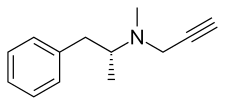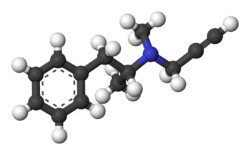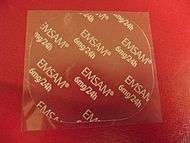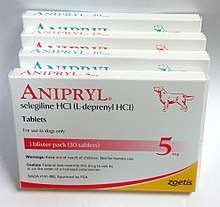Selegiline
 | |
 | |
| Clinical data | |
|---|---|
| Pronunciation | /səˈlɛdʒɪliːn/ sə-LEJ-i-leen |
| Trade names | Pill form is generic and available under many brand names;[1] transdermal patch is called Emsam |
| AHFS/Drugs.com | Monograph |
| MedlinePlus | a697046 |
| License data |
|
| Pregnancy category | |
| Routes of administration | Oral, transdermal |
| ATC code | |
| Legal status | |
| Legal status | |
| Pharmacokinetic data | |
| Bioavailability | 10% (oral), 73% (patch) |
| Protein binding | 94% |
| Metabolism | In the gut wall and liver |
| Metabolites | N-desmethylselegiline, L-amphetamine and L-methamphetamine |
| Elimination half-life | 10 hours (oral), 18–25 hours (transdermal) |
| Excretion | urine |
| Identifiers | |
| |
| CAS Number | |
| PubChem CID | |
| IUPHAR/BPS | |
| DrugBank | |
| ChemSpider | |
| UNII | |
| KEGG | |
| ChEBI | |
| ChEMBL | |
| ECHA InfoCard |
100.109.269 |
| Chemical and physical data | |
| Formula | C13H17N |
| Molar mass | 187.281 g/mol |
| 3D model (JSmol) | |
| |
| |
| (verify) | |
Selegiline, also known as L-deprenyl, is a substituted phenethylamine. At normal clinical doses, it is a selective irreversible MAO-B inhibitor. In larger doses it loses its specificity and also inhibits MAO-A. It is available in pill form under many brand names[1] and is used to reduce symptoms in early-stage Parkinson's disease. A transdermal patch (brand name, Emsam) is used to treat depression.
Medical uses
Parkinson's disease
In its pill form, selegiline is used to treat symptoms of Parkinson's disease.[2] It is most often used an adjunct to drugs such as L-DOPA, although it has been used off-label as a solo treatment.[3][4] The rationale for adding selegiline to levodopa is to decrease the required dose of levodopa and thus reduce the motor complications of levodopa therapy.[5] Selegiline delays the point when L-DOPA (levodopa) treatment becomes necessary from about 11 months to about 18 months after diagnosis.[6] There is some evidence that selegiline acts as a neuroprotective and reduces the rate of disease progression, though this is disputed.[4][5]
Selegiline has also been used off-label as a palliative treatment for dementia in Alzheimer's disease.[4]
Depression
Selegiline is also delivered via a transdermal patch used as a treatment for major depressive disorder.[7][8]
A quantitative review published in 2015 found that for the pooled results of the pivotal trials, the number needed to treat (a sign of effect size, so a low number is better) for the patch for symptom reduction was 11, and for remission, was 9.[8] The number needed to harm (inverse of the NNT, a high number here is better) ranged from 387 for sexual side effects to 7 for application site reaction.[8] With regard to the likelihood to be helped or harmed (LHH), the analysis showed that the selegiline patch was 3.6 times as likely to lead to a remission vs. a discontinuation due to side effects; the LHH for remission vs. incidence of insomnia was 2.1; the LHH for remission vs. discontinuation due to insomnia was 32.7. The LHH for remission vs insomnia and sexual dysfunction were both very low.[8]
Special populations
For all human uses and all forms, selegiline is pregnancy category C: studies in pregnant lab animals have shown adverse effects on the fetus but there are no adequate studies in humans.[2][7]
Adverse effects
Side effects of the pill form include, in decreasing order of frequency, nausea, hallucinations, confusion, depression, loss of balance, insomnia, increased involuntary movements, agitation, slow or irregular heart rate, delusions, hypertension, new or increased angina pectoris, and syncope.[2] Most of the side effects are due to a high dopamine activity, and can be alleviated by reducing the dose of levadopa.[1]
The main side effects of the patch form for depression included application-site reactions, insomnia, diarrhea, and sore throat.[7] The selegiline patch carries a black box warning about a possible increased risk of suicide, especially for young people,[7] as do all antidepressants since 2007.[9]
Interactions
Both the oral and patch forms come with strong warnings against combining selegiline with drugs that could produce serotonin syndrome, such as SSRIs and the cough medicine dextromethorphan.[2][7][10] Selegiline in combination with the opioid analgesic pethidine is not recommended, as it can lead to severe adverse effects.[10] Several other synthetic opioids such as tramadol and methadone, as well as various triptans, are contraindicated due to potential for serotonin syndrome.[11][12]
Oral contraceptives increases selegiline's bioavailability 10- to 20-fold.[13] High levels can lead to loss of MAO-B selectivity, and selegiline may begin inhibition MAO-A as well. This increases susceptibility to side effects of unselective MAOIs, such as tyramine-induced hypertensive crisis and serotonin toxicity when combined with serotonergics.[13]
Both forms of the drug carry warnings about food restrictions to avoid hypertensive crisis that are associated with MAO inhibitors.[2][7] The patch form was created in part to overcome food restrictions; clinical trials showed that it was successful. Additionally, in post-marketing surveillance from April 2006 to October 2010, only 13 self-reports of possible hypertensive events or hypertension were made out of 29,141 exposures to the drug, and none were accompanied by objective clinical data.[8] The lowest dose of the patch method of delivery, 6 mg/24 hours, does not require any dietary restrictions.[14] Higher doses of the patch and oral formulations, whether in combination with the older non-selective MAOIs or in combination with the reversible MAO-A inhibitor moclobemide, require a low-tyramine diet.[10]
Pharmacology
Mechanism of action
Selegiline is a selective inhibitor of MAO-B in the nigrostriatal pathway of the brain, irreversibly inhibiting it by binding to it covalently.[1][15] It exerts effects by blocking the breakdown of dopamine, thus increasing its activity.[16] Its possible neuroprotective properties may be due to protecting nearby neurons from the free oxygen radicals that are released by MAO-B activity. At higher doses, selegiline loses its selectivity for MAO-B and inhibits MAO-A as well.[1]
Selegiline also inhibits CYP2A6 and can increase the effects of nicotine as a result.[17] Selegiline also appears to activate σ1 receptors, having a relatively high affinity of approximately 400 nM.[18][19]
Pharmacokinetics
Selegiline has an oral bioavailability of about 10%, which increases when ingested together with fatty meal, as the molecule is fat soluble.[1][20] Selegiline and its metabolites bind extensively to plasma proteins (at a rate of 94%). They cross the blood-brain barrier and enter the brain, where they most concentrated at the thalamus, basal ganglia, midbrain, and cingulate gyrus.[4][7]
Selegiline is mostly metabolized in the gut wall and liver; it and its metabolites are excreted in the urine.[1]
Metabolism
Selegiline is metabolized by cytochrome P450 to L-desmethylselegiline and L-methylamphetamine, the latter being one of the enantiomers of methamphetamine.[21][22] Desmethylselegiline has some activity against MAO-B, but it is much smaller than selegiline's.[16][15] It thought to be further metabolized by CYP2C19.[23] L-methamphetamine is converted to L-amphetamine (people taking selegiline may also test positive for amphetamine or methamphetamine on drug screening tests).[24] While the amphetamine metabolites may contribute to selegiline's ability to inhibit reuptake of the neurotransmitters dopamine and norepinephrine, they have also been associated with orthostatic hypotension and hallucinations in.[22][25][26] The amphetamine metabolites are hydroxylated and, in phase II, conjugated by glucuronyltransferase.
A newer anti-Parkinson MAO-B inhibitor, rasagiline, metabolizes into 1(R)-aminoindan, which has no amphetamine-like characteristics.[27]
Patch
Following application of the patch to humans, an average of 25% to 30% of the selegiline content is delivered systemically over 24 hours. Transdermal dosing results in significantly higher exposure to selegiline and lower exposure to all metabolites when compared to oral dosing; this is due to the extensive first-pass metabolism of the pill form and low first-pass metabolism of the patch form. The site of application is not a significant factor in how the drug is distributed. In humans, selegiline does not accumulate in the skin, nor is it metabolized there.[7]
Chemistry
Selegiline belongs to a class of drugs called phenethylamines. Selegiline is an L-methamphetamine derivative with a propargyl group attached to the nitrogen atom. This detail is borrowed from pargyline, an older phenethylamine MAO-B inhibitor.[28]
Selegiline, N-methyl-N-(2-propynyl)-2-methyl-1-phenylethyl-2-amine, is synthesized by the alkylation of (–)-methamphetamine using propargyl bromide.[29][30][31][32]

History
Following the discovery that the tuberculosis drug iproniazid elevated the mood of people taking it, and the subsequent discovery that the effect was likely due to inhibition of MAO, many people and companies started trying to discover MAO inhibitors to use as antidepressants. Selegiline was discovered by Z. Ecseri at the Hungarian drug company, Chinoin (part of Sanofi since 1993),[33] which they called E-250.[34]:66–67 Chinoin received a patent on the drug in 1962 and the compound was first published in the scientific literature in English in 1965.[34]:67[35] Work on the biology and effects of E-250 in animals and humans was conducted by a group led by József Knoll at Semmelweis University which was also in Budapest.[34]:67

Deprenyl is a racemic compound a mixture of two isomers called enantiomers. Further work determined that the levorotatory enantiomer was a more potent MAO-inhibitor, which was published in 1967, and subsequent work was done with the single enantiomer L-deprenyl.[34]:67[36][37]
In 1971, Knoll showed that selegiline selectively inhibits the B-isoform of monoamine oxidase (MAO-B) and proposed that it is unlikely to cause the infamous "cheese effect" (hypertensive crisis resulting from consuming foods containing tyramine) that occurs with non-selective MAO inhibitors. A few years later, two Parkinson's disease researchers based in Vienna, Peter Riederer and Walther Birkmayer, realized that selegiline could be useful in Parkinson's disease. One of their colleagues, Prof. Moussa B.H. Youdim, visited Knoll in Budapest and took selegiline from him to Vienna. In 1975, Birkmayer's group published the first paper on the effect of selegiline in Parkinson's disease.[37][38]
The discovery that selegiline seemed to have a neuroprotection effect in Parkinson's disease led to widespread speculation in the 1970s that it could be useful as an anti-aging drug.[39]
In 1987 Somerset Pharmaceuticals in New Jersey, which had acquired the US rights to develop selegiline, filed a new drug application (NDA) with the FDA to market the drug for Parkinson's disease in the US.[40] While the NDA was under review, Somerset was acquired in a joint venture by two generic drug companies, Mylan and Bolan Pharmaceuticals.[40] Selegiline was approved for Parkinson's disease by the FDA in 1989.[40]
In the 1990s, J. Alexander Bodkin at McLean Hospital, an affiliate of Harvard Medical School, began a collaboration with Somerset to develop delivery of selegiline via a transdermal patch in order to avoid the well known dietary restrictions of MAO inhibitors.[39][41][42] Somerset obtained FDA approval to market the patch in 2006.[43]
Research
A selegiline transdermal patch was tested for its effectiveness in treating ADHD.[44]
Selegiline's effectiveness in helping people stop smoking tobacco or cannabis has been studied.[45][46]
Society and culture
Due to the structural similarity to amphetamine, selegiline has been classified as a controlled substance in Japan and thus can only be obtained with a prescription or special government license. Amphetamine and methamphetamine are illegal in the country.
In E for Ecstasy (a book examining the uses of the street drug ecstasy in the UK) the writer, activist and ecstasy advocate Nicholas Saunders highlighted test results showing that certain consignments of the drug also contained selegiline.[47] Consignments of ecstasy known as "Strawberry" contained what Saunders described as a "potentially dangerous combination of ketamine, ephedrine and selegiline," as did a consignment of "Sitting Duck" Ecstasy tablets.[48]
In the US, selegiline is available by prescription, but is not scheduled as a controlled substance.
Veterinary use

In veterinary medicine, selegiline is sold under the brand name Anipryl (manufactured by Zoetis). It is used in dogs to treat canine cognitive dysfunction and, at higher doses, pituitary-dependent hyperadrenocorticism (PDH).[49][50] Canine cognitive dysfunction is a form of dementia that mimics Alzheimer's disease in humans. Geriatric dogs treated with selegiline show improvements in sleeping pattern, reduced incontinence, and increased activity level; most show improvements by one month.[51][52] Though it is labeled for dog use only, selegiline has been used off-label for geriatric cats with cognitive dysfunction.[53]
Selegiline's efficacy in treating pituitary-dependent hyperadrenocorticism has been disputed.[49] Theoretically, it works by increasing dopamine levels, which downregulates the release of ACTH, eventually leading to reduced levels of cortisol.[53] Some claim that selegiline is only effective at treating PDH caused by lesions in the anterior pituitary (which comprise most canine cases).[54] The greatest sign of improvement is lessening of abdominal distention.[51]
Side effects in dogs are uncommon, but they include vomiting, diarrhea, diminished hearing, salivation, decreased weight and behavioral changes such as hyperactivity, listlessness, disorientation, and repetitive motions.[50][54]
Selegiline does not appear to have a clinical effect on horses.[54]
See also
- D-Deprenyl
- Rasagiline
- Tranylcypromine
- Nordeprenyl
References
- 1 2 3 4 5 6 7 "Selegiline". Drugs.com. Retrieved February 7, 2016.
- 1 2 3 4 5 Selegiline oral label. Updated December 31, 2008
- ↑ Riederer P, Lachenmayer L, Laux G (August 2004). "Clinical applications of MAO-inhibitors". Curr. Med. Chem. 11 (15): 2033–43. doi:10.2174/0929867043364775. PMID 15279566.
- 1 2 3 4 "Selegiline Hydrochloride Monograph for Professionals". Drugs.com. Retrieved February 23, 2018.
- 1 2 Ives NJ, Stowe RL, Marro J, et al. (September 2004). "Monoamine oxidase type B inhibitors in early Parkinson's disease: meta-analysis of 17 randomised trials involving 3525 patients". BMJ. 329 (7466): 593. doi:10.1136/bmj.38184.606169.AE. PMC 516655. PMID 15310558.
- ↑ Riederer P, Lachenmayer L (November 2003). "Selegiline's neuroprotective capacity revisited". Journal of Neural Transmission. 110 (11): 1273–8. doi:10.1007/s00702-003-0083-x. PMID 14628191.
- 1 2 3 4 5 6 7 8 Emsam label Last revised Sept 2014. Index page at FDA
- 1 2 3 4 5 Citrome, Leslie; Goldberg, Joseph F.; Portland, Kimberly Blanchard (November 2013). "Placing transdermal selegiline for major depressive disorder into clinical context: number needed to treat, number needed to harm, and likelihood to be helped or harmed" (PDF). Journal of Affective Disorders. 151 (2): 409–417. doi:10.1016/j.jad.2013.06.027. ISSN 1573-2517. PMID 23890583.
- ↑ Friedman, Richard A.; Leon, Andrew C. (June 7, 2007). "Expanding the black box - depression, antidepressants, and the risk of suicide". The New England Journal of Medicine. 356 (23): 2343–2346. doi:10.1056/NEJMp078015. ISSN 1533-4406. PMID 17485726.
- 1 2 3 Heinonen, Esa; Myllylä, Vilho (July 1, 1998). "Safety of Selegiline (Deprenyl) in the Treatment of Parkinson's Disease". Drug Safety. 19 (1): 11–22. doi:10.2165/00002018-199819010-00002. ISSN 0114-5916. PMID 9673855.
- ↑ Csoti, Ilona; Storch, Alexander; Müller, Walter; Jost, Wolfgang H. (December 1, 2012). "Drug interactions with selegiline versus rasagiline". Basal Ganglia. Monoamine oxidase B Inhibitors. 2 (4, Supplement): S27–S31. doi:10.1016/j.baga.2012.06.003. ISSN 2210-5336.
- ↑ Gillman, P. K. (October 2005). "Monoamine oxidase inhibitors, opioid analgesics and serotonin toxicity". British Journal of Anaesthesia. 95 (4): 434–441. doi:10.1093/bja/aei210. ISSN 0007-0912. PMID 16051647.
- 1 2 Laine, Kari; Anttila, Markku; Helminen, Antti; Karnani, Hari; Huupponen, Risto (2001). "Dose linearity study of selegiline pharmacokinetics after oral administration: Evidence for strong drug interaction with female sex steroids". British Journal of Clinical Pharmacology. 47 (3): 249–54. doi:10.1046/j.1365-2125.1999.00891.x. PMC 2014223. PMID 10215747.
- ↑ Jessen, Lois; Kovalick, Lawrence J.; Azzaro, Albert J. (April 22, 2017). "The Selegiline Transdermal System (Emsam)". Pharmacy and Therapeutics. 33 (4): 212–246. ISSN 1052-1372. PMC 2730099. PMID 19750165.
- 1 2 Factor, Steward A.; Weiner, William (2007). Parkinson's Disease: Diagnosis & Clinical Management (2nd ed.). Demos Medical Publishing. pp. 503, 505. ISBN 978-1-934559-87-1.
- 1 2 Katzung, Bertram G. (2004). Basic and Clinical Pharmacology (9th ed.). Lange Medical Books/McGraw Hill. p. 453. ISBN 978-0-07-141092-2.
- ↑ Siu, E. C.; Tyndale, R. F. (2008). "Selegiline is a mechanism-based inactivator of CYP2A6 inhibiting nicotine metabolism in humans and mice". Journal of Pharmacology and Experimental Therapeutics. 324 (3): 992–9. doi:10.1124/jpet.107.133900. PMID 18065502.
- ↑ Itzhak, Yossef (1994). Sigma Receptors. Academic Press. p. 84. ISBN 978-0-12-376350-1.
- ↑ Stone, T. W. (1993). Acetylcholine, Sigma Receptors, CCK and Eicosanoids, Neurotoxins. Taylor & Francis. p. 124. ISBN 978-0-7484-0063-8.
- ↑ Barrett, Jeffrey S.; Szego, Peter; Rohatagi, Shashank; Morales, Richard J.; Dewitt, Kimberly E.; Rajewski, Gregory; Ireland, Joyce (1996). "Absorption and presystemic metabolism of selegiline hydrochloride at different regions in the gastrointestinal tract in healthy males". Pharmaceutical Research. 13 (10): 1535–40. doi:10.1023/A:1016035730754. PMID 8899847.
- ↑ Engberg, G; Elebring, T; Nissbrandt, H (1991). "Deprenyl (selegiline), a selective MAO-B inhibitor with active metabolites; effects on locomotor activity, dopaminergic neurotransmission and firing rate of nigral dopamine neurons". The Journal of Pharmacology and Experimental Therapeutics. 259 (2): 841–7. PMID 1658311.
- 1 2 Lemke, Thomas L.; Williams, David A, eds. (2012). Foye's Principles of Medicinal Chemistry. Lippincott Williams & Wilkins. p. 434. ISBN 1609133455.
- ↑ Taavitsainen, Paivi; Anttila, Markku; Nyman, Leena; Karnani, Hari; Salonen, Jarmo S.; Pelkonen, Olavi (2000). "Selegiline Metabolism and Cytochrome P450 Enzymes:In vitro Study in Human Liver Microsomes*". Pharmacology and Toxicology. 86 (5): 215–21. doi:10.1034/j.1600-0773.2000.pto860504.x. PMID 10862503.
- ↑ Romberg, R. W.; Needleman, S. B.; Snyder, J. J.; Greedan, A. (November 1, 1995). "Methamphetamine and amphetamine derived from the metabolism of selegiline". Journal of Forensic Sciences. 40 (6): 1100–1102. ISSN 0022-1198. PMID 8522918.
- ↑ Bar Am, Orit; Amit, Tamar; Youdim, Moussa B. H. (January 30, 2004). "Contrasting neuroprotective and neurotoxic actions of respective metabolites of anti-Parkinson drugs rasagiline and selegiline". Neuroscience Letters. 355 (3): 169–172. doi:10.1016/j.neulet.2003.10.067. ISSN 0304-3940. PMID 14732458.
- ↑ Yasar, S.; Goldberg, J. P.; Goldberg, S. R. (January 1, 1996). "Are metabolites of l-deprenyl (selegiline) useful or harmful? Indications from preclinical research". Journal of Neural Transmission. Supplementum. 48: 61–73. ISSN 0303-6995. PMID 8988462.
- ↑ Chen JJ, Swope DM (2005). "Clinical pharmacology of rasagiline: a novel, second-generation propargylamine for the treatment of Parkinson disease". J Clin Pharmacol. 45 (8): 878–94. doi:10.1177/0091270005277935. PMID 16027398. Archived from the original on 2012-07-11.
- ↑ Miklya, Ildiko (March 13, 2014). "The History of Selegiline/(-)-Deprenyl the First Selective Inhibitor of B-Type Monoamine Oxidase and The First Synthetic Catecholaminergic Activity Enhancer Substance". International Network for the History of Neuropsychopharmacology. Retrieved January 7, 2016.
- ↑ J. Knoll, E. Sanfai, DE 1568277 (1966).
- ↑ J. Hermann Nee Voeroes, Z. Ecsery, G. Sabo, L. Arvai, L. Nagi, O. Orban, E. Sanfai, U.S. Patent 4,564,706 (1986)
- ↑ B. Brunova, M. Ferenc, EP 344675 (1989)
- ↑ Fowler, Joanna S. (1977). "2-Methyl-3-butyn-2-ol as an acetylene precursor in the Mannich reaction. A new synthesis of suicide inactivators of monoamine oxidase". The Journal of Organic Chemistry. 42 (15): 2637–7. doi:10.1021/jo00435a026. PMID 874623.
- ↑ "Sanofi Extends Holding in Chinoin". The Pharma Letter. September 19, 1993. (Subscription required (help)).
- 1 2 3 4 Magyar, Kálmán (2011). "The pharmacology of selegiline". In Youdim, Moussa; Riederer, Peter. Monoamine Oxidases and Their Inhibitors. International Review of Neurobiolgoy. 100. Academic Press. ISBN 978-0-12-386468-0.
- ↑ Knoll J, Ecseri Z, Kelemen K, Nievel J, Knoll B (May 1965). "Phenylisopropylmethylpropinylamine (E-250), a new spectrum psychic energizer". Arch Int Pharmacodyn Ther. 155 (1): 154–64. PMID 4378644.
- ↑ Magyar K, Vizi ES, Ecseri Z, Knoll J (1967). "Comparative pharmacological analysis of the optical isomers of phenyl-isopropyl-methyl-propinylamine (E-250)". Acta Physiol Acad Sci Hung. 32 (4): 377–87. PMID 5595908.
- 1 2 Healy, David (2000). "The psychopharmacology of life and death. Interview with Joseph Knoll.". The Psychopharmacologists, Vol. III: Interviews. London: Arnold. pp. 81–110. ISBN 0-340-76110-5.
- ↑ Birkmayer W, Riederer P, Youdim MB, Linauer W (1975). "The potentiation of the anti akinetic effect after L-dopa treatment by an inhibitor of MAO-B, Deprenil". J. Neural Transm. 36 (3–4): 303–26. doi:10.1007/BF01253131. PMID 1172524. Archived from the original on 2013-02-12.
- 1 2 William J. Cromie (November 7, 2002). "Bodkin is Patching up Depression". Harvard University Gazette. Retrieved September 8, 2007.
- 1 2 3 Seaman, John T.; Landry, John T. (2011). Mylan: 50 Years of Unconventional Success: Making Quality Medicine Affordable and Accessible. University Press of New England. p. 50. ISBN 978-1-61168-269-4.
- ↑ Frampton, JE; Plosker, GL (2007). "Selegiline transdermal system: in the treatment of major depressive disorder". Drugs. 67 (2): 257–67, discussion 266–7. doi:10.2165/00003495-200767020-00006. PMID 17284087.
- ↑ Duffy, Mary (3 December 2002). "Patch Raises New Hope For Beating Depression". The New York Times. ISSN 0362-4331.
- ↑ Cascade EF, Kalali AH, Preskorn SH (Jun 2007). "Emsam: the first year". Psychiatry (Edgmont). 4 (6): 19–21. PMC 2921248. PMID 20711332.
- ↑ Akhondzadeh, Shahin; Tavakolian, Reza; Davari-Ashtiani, Rozita; Arabgol, Fariba; Amini, Homayoun (August 1, 2003). "Selegiline in the treatment of attention deficit hyperactivity disorder in children: a double blind and randomized trial". Progress in Neuro-Psychopharmacology & Biological Psychiatry. 27 (5): 841–845. doi:10.1016/S0278-5846(03)00117-9. ISSN 0278-5846. PMID 12921918.
- ↑ "Effectiveness of Selegiline in Treating Marijuana Dependent Individuals". ClinicalTrials.gov. National Institute on Drug Abuse. March 2005. Retrieved February 16, 2007.
- ↑ "Usefulness of Selegiline as an Aid to Quit Smoking". ClinicalTrials.gov. National Institute on Drug Abuse. July 2004. Retrieved February 16, 2007.
- ↑ Saunders, Nicholas; Heron, Liz (1993). E for Ecstasy. London: N. Saunders. ISBN 978-0-9501628-8-1. OCLC 29388575.
- ↑ Saunders, Nicholas. "Test results of 30 samples of Ecstasy bought in British clubs between 11/94 and 7/95".
- 1 2 Braddock JA, Church DB, Robertson ID (2004). "Selegiline Treatment of Canine Pituitary-Dependent Hyperadrenocorticism" (PDF). Australian Veterinary Journal. Archived from the original (PDF) on November 29, 2010. Retrieved April 8, 2011. (PDF)
- 1 2 Eghianruwa, Kingsley (2014). Essential Drug Data for Rational Therapy in Veterinary Practice. AuthorHouse. pp. 127–128. ISBN 978-1-4918-0010-2.
- 1 2 "Anipryl Tablets for Animal Use". Drugs.com. Retrieved August 31, 2017.
- ↑ Lundgren, Becky. "Canine Cognitive Dysfunction". Veterinary Partner. Retrieved April 8, 2011.
- 1 2 Riviere, Jim E.; Papich, Mark G. (2013). Veterinary Pharmacology and Therapeutics. John Wiley & Sons. p. 530. ISBN 978-1-118-68590-7.
- 1 2 3 Papich, Mark G. (2015). Saunders Handbook of Veterinary Drugs: Small and Large Animal. Elsevier Health Sciences. p. 722. ISBN 978-0-323-24485-5.